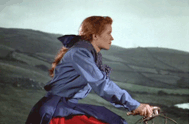As in Tren de sombras, José Luis Guerín ambiguously prefaces Innisfree as a series of images and observations recorded from the site of a historical event, in this case, the filming of John Ford’s The Quiet Man around Cong village in the Irish countryside. And like the film, Guerín alternates between modes of non-fiction – documentary and found footage – to explore the amorphous nature of image creation and representation, the impreciseness of translation, and the imprinting of historical (and geographical) memory. Guerín prefigures the deconstruction of Ford’s film (and, implicitly, Ford’s persona as the town’s famed native son) in the opening commentary by the director’s friend and colleague, Michael Killanin (producer of The Rising of the Moon) on the absence of primogeniture tradition in Irish culture that had led to large scale emigration during the last century (as subsistence farmers inherited subdivided land or were completely disinherited and forced to seek their fortune elsewhere). Framed against a shot of two men (presumably Ford’s relatives, the O’Feeneys) surveying the stone wall ruins of a farmhouse, Guerín illustrates both the reality (of abandoned land) and implied fiction (of returning émigrés) intrinsic in Ford’s seemingly autofictional premise of an Irish American boxer, Sean Thornton (John Wayne) returning to his ancestral land in order to reclaim his homestead.
This duality is also reflected in the juxtaposition of Killanin’s comments with the appearance of a hitchhiker. On one hand, Killanin points out that Thornton is, to some extent, an alterego (whose shared history with Ford involved immigrant parents who settled in Pittsburgh) and represents an idealized, other gaze that goes against the grain of historical reality. On the other hand, the hitchhiker represents an antithesis to the immigrant story by describing her experience as having worked as an au pair and in a millinery factory in Pittsburgh before deciding to return home to Ireland. The convergence of disparate realities is further developed in the young woman’s employment as a concession stand attendant for one of the local, film-themed sightseeing tours that now capitalize on the popularity of The Quiet Man. In a sense, fiction and reality not only coexist (an idea that is also suggested in the deliberately staged shot of the attendant, still in her Maureen O’Hara costume, riding home that evokes a shot of the bicycling couple in Ford’s film), but that fiction has also transfigured into reality by creating (and perpetuating) its own illusion.
The transformation of Innisfree from scouted, rustic town suitable for the location shoot to one now defined by – and economically reliant on – perpetuating the fictional images created by the film also reflects Guerín’s theme of cinema as simultaneously a medium of illusion and conjurer of reality (a theme that also surfaces in Tren de sombras in the figurative conjuring of the dead by restoring amateur filmmaker, Fleury’s lost film from the turn of the century). In one episode, film reality diverges from geographic reality when an IRA partisan describes the war torn, mine-filled landscape that was cleared to create the film’s idyllic images of pastoral life. In a subsequent episode, the two realities again converge in a staged explosion caused by an errant cow for Guerín’s film. In both cases, the landscape has been altered by artificially constructed, historical realities. Similarly, by using repeated shots of the attendant shuffling full-scale cutouts of John Wayne and Maureen O’Hara at a tour site (the scenes wryly cued by opening and closing the shutters of the small, puppet-theater sized concession stand), Guerín reflects on the idea that the town, too, has become a modern day, real-life staged spectacle. Concluding with images of the hitchhiker moving on to another town in search of job opportunities, she becomes an embodiment of the immigrant paradigm and a traveling performer for Guerín’s camera.
© Acquarello 2009. All rights reserved.
